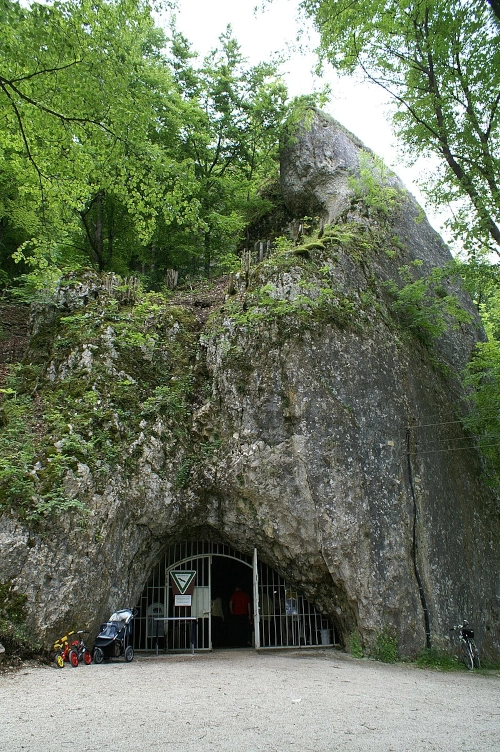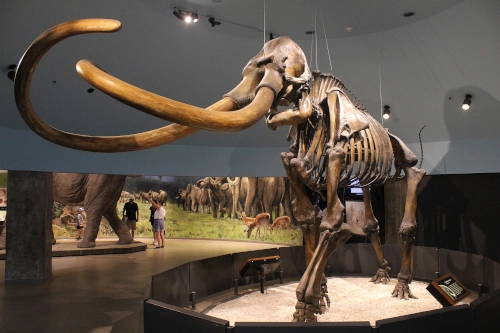It is a small, stylized figurine that is believed to be around 35,000 years old. It was created during the Upper Paleolithic period, and it is made from mammoth ivory.
The Venus of Hohle Fels is one of the oldest examples of figurative art in the world, and it has challenged our assumptions about the capabilities of our ancient ancestors.
In 2008, a team of archaeologists excavating the Hohle Fels cave in Germany made an extraordinary discovery. A small figurine carved from mammoth ivory. This figurine, known as the Venus of Hohle Fels, has since become one of the most significant pieces of prehistoric art ever discovered.
In this article, we’ll take a closer look at the Venus of Hohle Fels and explore its historical and cultural significance.
Discovery and History
The Venus of Hohle Fels was discovered in September 2008 by a team of archaeologists led by Nicholas Conard. The Hohle Fels cave, located in southwestern Germany, had been known to contain artifacts from the Upper Paleolithic period, which dates back to around 40,000 to 10,000 BCE.
However, the discovery of the Venus of Hohle Fels was still a surprise.
The Venus of Hohle Fels is believed to be around 35,000 years old, making it one of the oldest examples of figurative art in the world. The small, carved figurine measures just over six centimeters in length and is made from mammoth ivory.
The figurine is highly stylized, with exaggerated features that accentuate the breasts, hips, and genitalia.
Nicholas Conard
Nicholas Conard is a renowned German archaeologist and prehistorian who is best known for his discovery of the Venus of Hohle Fels. Conard was born in the United States in 1961 or 1962, and he later moved to Germany to pursue his studies in archaeology.

Nicholas Conard at the University of Tübingen Museum (2013)
After earning his PhD from the University of Tübingen in 1994, Conard joined the faculty as an expert in prehistory and archaeology. He has also held leadership roles at other universities across the globe, such as the University of Vienna and the University of California, Berkeley.
Conard has been involved in many significant archaeological discoveries throughout his career. He is perhaps best known for his discovery of the Venus of Hohle Fels in 2008, which has been described as one of the most important prehistoric artifacts ever discovered. The Venus of Hohle Fels is a small figurine made from mammoth ivory that is believed to be around 35,000 years old. The figurine is highly stylized and has been the subject of significant study and research since its discovery.
Conard has also been involved in other important archeological finds, such as the discovery of the Lion Man figurine and a flute made of vulture wing bone that dates back 40,000 years. These discoveries have made a significant impact on how well we comprehend prehistoric art and culture.
Conard’s work in archaeology and prehistory has been widely recognized, and he has received numerous awards and honors for his contributions to the field. He has published many scholarly articles and books on prehistoric art and culture, and he continues to be actively involved in research and excavation projects around the world.
The Hohle Fels Cave Is A Portal to Prehistory
Deep within the rugged landscape of southwestern Germany, hidden away from the hustle and bustle of modern civilization, lies the Hohle Fels Cave. This unassuming natural wonder has become one of the most significant archaeological sites in the world, offering us a glimpse into the lives of our ancient ancestors.

The hollow rock near Schelklingen in the Alb-Danube district is a sponge pest of the White Jura. The sugarloaf-shaped rock lies in the valley of the Urdonau.
The Hohle Fels Cave was first discovered in 1870 by a local teacher, and it has been the site of numerous excavations and studies ever since. The cave is nestled in the Swabian Jura, a region known for its rugged terrain and its abundance of prehistoric artifacts. The cave itself is located in a limestone cliff, and it can only be reached by a narrow footpath that winds its way through the dense forest.
The Hohle Fels Cave has been the site of many significant discoveries over the years, including the Venus of Hohle Fels, a small figurine made from mammoth ivory that is believed to be around 35,000 years old. The cave has also yielded many other prehistoric artifacts, including tools, weapons, and jewelry, all of which have contributed to our understanding of prehistoric life and culture.
The Hohle Fels Cave is more than just a collection of artifacts, however. It is a portal to the past, a window into a world that existed long before modern civilization. The cave is a testament to the creativity, ingenuity, and resilience of our ancient ancestors, who thrived in this rugged landscape thousands of years ago.
The Hohle Fels Cave is also a place of mystery and wonder, filled with the echoes of a long-forgotten past. It is a place where the past and present come together, where we can stand in awe of the wonders of our ancient heritage.
Visiting the Hohle Fels Cave is an experience like no other. The narrow footpath that winds through the forest leads you to a hidden world, a world of secrets and surprises. As you step into the cool darkness of the cave, you can feel the weight of history pressing down upon you. You can almost hear the whispers of our ancient ancestors, telling stories of a time long ago.
The Hohle Fels Cave is a living, breathing monument to our past, and it reminds us of the rich cultural heritage that we all share. It is a reminder of our connection to the natural world, and of the limitless potential of the human spirit.
In a world that often seems obsessed with the latest technology and the newest innovations, the Hohle Fels Cave offers us a different perspective. It is a place of simplicity, of beauty, and of wonder, where we can step back in time and explore the mysteries of the past. It is a place that deserves to be treasured and protected, so that future generations can experience the magic of the Hohle Fels Cave and the wonders of prehistory.
The Venus of Hohle Fels Characteristics
The Venus of Hohle Fels is highly symbolic, and many interpretations have been put forward to explain its meaning. Some researchers suggest that the figurine was a fertility symbol, while others believe that it was a representation of a goddess or female ancestor. Regardless of its precise meaning, the Venus of Hohle Fels is a masterpiece of prehistoric art, and its stylized form has influenced countless artists throughout history.
The Venus of Hohle Fels is similar in some ways to other prehistoric figurines found in Europe, such as the Venus of Willendorf and the Venus of Lespugue. However, the Venus of Hohle Fels is unique in its exaggerated features and the intricate detail of its carving.
What is the significance of the Venus of Hohle Fels?
The Venus of Hohle Fels is not only significant as a work of art but also as a window into the past. The figurine is one of the earliest examples of figurative art, and it provides insight into the beliefs and values of the people who created it. The Venus of Hohle Fels is also significant in its cultural context, as it was created during a time of great social and technological change.
The cultural significance of the Venus of Hohle Fels is evident in the many theories that have been put forward to explain its meaning. Some researchers believe that the Venus of Hohle Fels was a fertility symbol, while others suggest that it was a representation of a goddess or a female ancestor. Regardless of its precise meaning, the Venus of Hohle Fels is a testament to the creativity and skill of its creators.
How Was The Venus Of Hohle Fels Created?
The people who created the Venus of Hohle Fels were part of a culture that thrived during the Upper Paleolithic period. This period was characterized by significant advancements in technology, including the development of tools made from stone, bone, and antler.
The Venus of Hohle Fels was created during a time when humans were beginning to settle into more permanent communities, and it is believed that the figurine played an important role in the social and religious life of these communities.
What Is The Cultural Context Of The Venus Of Hohle Fels?
The Venus of Hohle Fels was created in a cultural environment that dates back to the Upper Paleolithic, between roughly 40,000 and 10,000 BCE. The people who made the Venus of Hohle Fels at this period were nomadic, small-town dwellers who survived by hunting, fishing, and gathering.
During a time of profound technological and societal change, the Venus of Hohle Fels was produced. Humans were creating new tools and methods for producing food, clothing, and other necessities, and they were establishing more stable communities. Significant changes in social and religious customs followed this shift from a nomadic to a settled way of life.
It is thought that the Venus of Hohle Fels had a significant impact on the social and religious life of its creators. While some scholars contend that the figurine was a representation of a deity or female ancestor, others contend that it was a fertility symbol. Whatever its exact significance, the Venus of Hohle Fels was a prized artifact that was probably used in ceremonies and traditions that were essential to the people who made it.
The Venus of Hohle Fels was produced within a larger artistic and cultural heritage, not in a vacuum. Similar figurines have been discovered all over Europe, and it is thought that the cultures that produced them assigned them similar duties. These sculptures are a part of a larger body of prehistoric art, which also includes carvings, paintings, and other artifacts. These artifacts all shed light on the beliefs, values, and customs of our distant forebears.
In summary, the Venus of Hohle Fels was made during a time of major technological and cultural change, and the people who made it placed great value on the figurine in their social and religious lives. The Venus of Hohle Fels is a reminder of the rich cultural heritage that we all share and a testament to the ingenuity and skill of our prehistoric forebears.
How Has Technology Been Used To Study The Venus Of Hohle Fels And What Has Been Learned As A Result?
The Venus of Hohle Fels has been the subject of significant research and study over the years. Scientists have used a variety of techniques to study the figurine, including radiocarbon dating and 3D imaging. These studies have provided valuable insights into the techniques used to create the Venus of Hohle Fels, as well as the cultural context in which it was made.
The Venus of Hohle Fels: Unveiling the Secrets of the Past with Technology
The Venus of Hohle Fels is a masterpiece of prehistoric art that has been the subject of significant study and research since its discovery in 2008.
The figurine is believed to be around 35,000 years old and is made from mammoth ivory. Since its discovery, researchers have used a variety of techniques and technologies to study the Venus of Hohle Fels and to gain insights into the culture and beliefs of the people who created it.
One of the most significant technological advances in the study of the Venus of Hohle Fels has been the use of digital imaging techniques.
Researchers have used 3D scanning technology to create highly detailed digital models of the figurine, which have allowed them to study the Venus of Hohle Fels in ways that were not previously possible. These digital models have revealed previously hidden details about the figurine, such as the intricate patterns carved into the back of the Venus of Hohle Fels.
Another important technology that has been used in the study of the Venus of Hohle Fels is radiocarbon dating. Radiocarbon dating is a technique that allows researchers to determine the age of an object by analyzing the decay of radioactive carbon isotopes. By using radiocarbon dating, researchers have been able to confirm the approximate age of the Venus of Hohle Fels and to place it in its proper historical context.
In addition to digital imaging and radiocarbon dating, researchers have also used other techniques to study the Venus of Hohle Fels. For example, they have used scanning electron microscopy to analyze the surface of the figurine and to identify the pigments used to decorate it. They have also used X-ray fluorescence spectroscopy to analyze the elemental composition of the figurine and to identify the materials used to make it.
Through the use of these technologies, researchers have been able to gain significant insights into the culture and beliefs of the people who created the Venus of Hohle Fels. For example, the use of red ochre pigment on the figurine suggests that it played an important role in prehistoric rituals and ceremonies. The intricate patterns carved into the back of the Venus of Hohle Fels also suggest that it was a highly valued object, and that its creation required significant skill and expertise.
The use of technology has been critical in unlocking the secrets of the Venus of Hohle Fels, and it has helped us to gain a deeper understanding of the prehistoric past. As researchers continue to study this masterpiece of prehistoric art, we can expect to gain even deeper insights into the lives, beliefs, and practices of our ancient ancestors. The Venus of Hohle Fels is a reminder of the rich cultural heritage of our species, and it is a testament to the limitless potential of the human spirit.
What Is The Venus Of Hohle Fels Made Of?
One of the most significant findings related to the Venus of Hohle Fels was the discovery that the figurine was covered in red ochre, a pigment that has been used in many prehistoric works of art. The use of red ochre suggests that the Venus of Hohle Fels was a highly valued object and may have played an important role in prehistoric rituals.

Skeleton of Mammuthus columbi on display at the Page Museum at the La Brea Tar Pits.
The mammoth ivory used to create the Venus of Hohle Fels is an uncommon and challenging material to work with. The Venus of Hohle Fels is considered to have been carved and polished using a combination of methods, enabling the ancient artists to produce the intricate and stylized features that make the figurine such an exceptional piece of art.
The longevity of the mammoth ivory from which the Venus of Hohle Fels was carved is one reason why it is in such excellent condition after being around for more than 35,000 years. During the Upper Paleolithic era, mammoth ivory was frequently used for artistic purposes, and replicas of these pieces have been discovered at other locations across Europe.
How Has The Venus Of Hohle Fels Influenced Our Understanding Of Prehistoric Art?
The Venus of Hohle Fels is a small, stylized figurine that has had a big impact on our understanding of prehistoric art. This masterpiece of prehistoric art has challenged our assumptions about the capabilities of our ancient ancestors and has provided valuable insights into the culture and beliefs of the people who created it.
The Venus of Hohle Fels is one of the oldest examples of figurative art in the world, and it has played an important role in shaping our understanding of prehistoric art. Before the discovery of the Venus of Hohle Fels, many researchers believed that prehistoric art was limited to simple geometric shapes and abstract designs. However, the discovery of the Venus of Hohle Fels demonstrated that our ancient ancestors were capable of creating highly stylized and intricate works of art.
The Venus of Hohle Fels Shaping Our Understanding of Prehistoric Art
The Venus of Hohle Fels has also challenged our assumptions about the roles that prehistoric art played in society. The figurine is believed to have been a highly valued object, and it was likely used in rituals and ceremonies that were central to the culture of the people who created it. This suggests that prehistoric art was not just decorative, but rather played an important role in the social and religious life of prehistoric communities.
The Venus of Hohle Fels has also influenced our understanding of the techniques and materials used in prehistoric art. The figurine is made from mammoth ivory, a material that is difficult to work with, yet the artists who created the Venus of Hohle Fels were able to carve it with remarkable skill and precision. This has led researchers to reconsider their assumptions about the technological capabilities of prehistoric communities.
In addition to its impact on our understanding of prehistoric art, the Venus of Hohle Fels has also contributed to ongoing debates about the origins and evolution of human culture. The figurine is believed to have been created during a time of significant social and technological change, and it provides valuable insights into the ways in which our ancient ancestors adapted to these changes.
The Venus of Hohle Fels has had a profound impact on our understanding of prehistoric art and culture. It has challenged our assumptions, expanded our knowledge, and opened new avenues of inquiry. As researchers continue to study this masterpiece of prehistoric art, we can expect to gain even deeper insights into the lives, beliefs, and practices of our ancient ancestors. The Venus of Hohle Fels is a testament to the creativity, ingenuity, and resilience of our prehistoric forebears, and it reminds us of the limitless potential of the human spirit.
References
Venus of Hohle Fels pinterest.com/pin/1120974163470162623/
By Dr. Eugen Lehle – Own work, CC BY-SA 3.0, commons.wikimedia.org/w/index.php?curid=6833218
By Jonathan Chen – Own work, CC BY-SA 4.0, commons.wikimedia.org/w/index.php?curid=122327156
By Friedhelm Albrecht – https://www.flickr.com/photos/135201610%40N04/20246707002/in/photolist-wR8EBd, CC BY-SA 2.0, commons.wikimedia.org/w/index.php?curid=42050237






